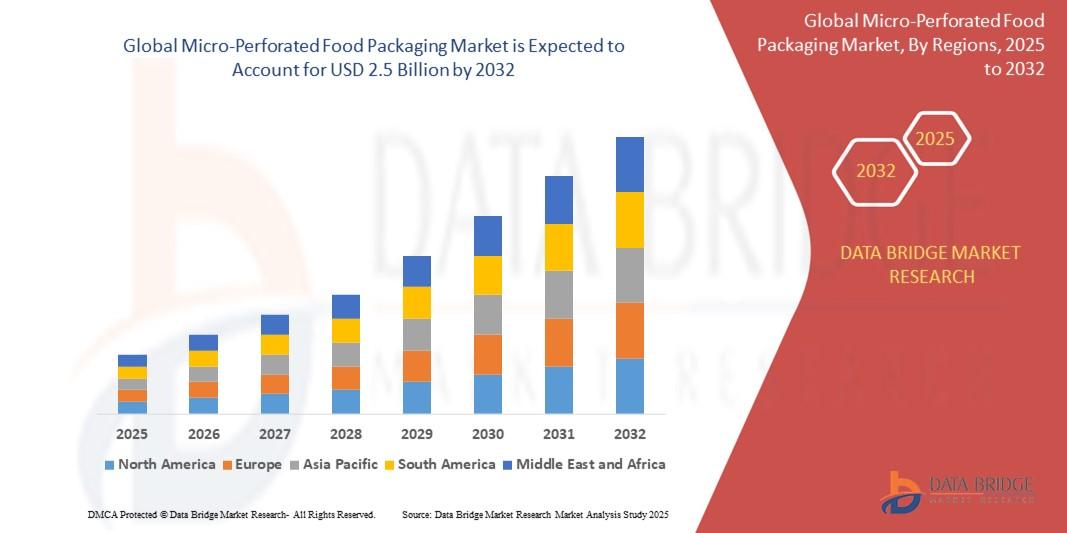Micro-Perforated Food Packaging Market Outlook: Growth, Trends, Size, and Segmentation Insights

Future of Executive Summary Micro-Perforated Food Packaging Market: Size and Share Dynamics
The global Micro-Perforated Food Packaging market size was valued at USD 1.6 billion in 2024 and is expected to reach USD 2.5 billion by 2032, at a CAGR of 5.3% during the forecast period
To thrive in this rapidly transforming marketplace, today’s businesses call for innovative and superlative solutions. Businesses can accomplish an unmatched insights and expertise of the best market opportunities into their relevant markets with the help of Micro-Perforated Food Packaging Market research report. This market report gives clear idea about the market potential for each geographical region based on the growth rate, macroeconomic parameters, consumer buying patterns, possible future trends, and market demand and supply scenarios. The steadfast Micro-Perforated Food Packaging Market report covers market analysis, market definition, market segmentation, key developments in the market, key players or competitor analysis and detailed research methodology.
By thinking from the customer point of view, a team of researchers, analysts and industry experts work carefully to generate the world class Micro-Perforated Food Packaging Market research report. Top players in the market, major collaborations, merger and acquisitions along with trending innovation and business policies are also re-evaluated in this market report. The report aims to examine the market with respect to general market conditions, market improvement, market scenarios, development, cost and profit of the specified market regions, position and comparative pricing between major players. To attain knowledge of the market factors, the transparent, extensive and supreme Micro-Perforated Food Packaging Market report is generated.
Tap into future trends and opportunities shaping the Micro-Perforated Food Packaging Market. Download the complete report:
https://www.databridgemarketresearch.com/reports/global-micro-perforated-food-packaging-market
Micro-Perforated Food Packaging Market Environment
Segments
- Based on material type, the micro-perforated food packaging market can be segmented into polyethylene (PE), polypropylene (PP), polyethylene terephthalate (PET), polyvinyl chloride (PVC), polyamide (PA), and others.
- Considering the packaging type, the market can be categorized into pouches & bags, trays, films, lids, wraps, and others.
- On the basis of application, the market can be divided into bakery products, fruits & vegetables, meat, poultry & seafood, ready-to-eat food, dairy products, and others.
- Geographically, the market can be analyzed across North America, Europe, Asia-Pacific, South America, and Middle East & Africa regions.
Micro-perforated food packaging offers several advantages such as extended shelf life, improved product presentation, and better airflow control, which have led to its widespread adoption across various industries.
Market Players
- Amcor plc
- Sealed Air
- Mondi
- COVERIS
- BASF SE
- SC Johnson Professional
- Amerplast
- Uflex
- TCL Packaging Ltd
- CONSTANTIA
- Asahi Kasei Corporation
- Flextrus AB
- HFM Packaging Ltd
- Bollore Group
- Schur Flexibles Group
These key players in the micro-perforated food packaging market are focusing on strategic initiatives like mergers, acquisitions, partnerships, and product innovations to enhance their market presence and expand their product offerings.
The global micro-perforated food packaging market is witnessing significant growth, driven by the increasing demand for convenient and sustainable packaging solutions in the food industry. The rise in consumption of packaged food products, growing awareness about food safety, and advancements in packaging technologies are some of the key factors fueling market growth. Additionally, stringent regulations regarding food packaging materials and the emphasis on reducing food wastage are further propelling the adoption of micro-perforated packaging solutions.
North America and Europe hold a substantial share in the micro-perforated food packaging market, attributed to the presence of major food processing industries and the high disposable income of consumers in these regions. On the other hand, the Asia-Pacific region is expected to witness rapid growth in the market due to the increasing urbanization, changing lifestyle patterns, and rising awareness about food quality and safety among consumers.
In conclusion, the global micro-perforated food packaging market is poised for significant growth in the coming years, driven by the need for sustainable packaging solutions, technological advancements, and changing consumer preferences. Key players in the market are focusing on innovation and strategic collaborations to stay competitive in this rapidly evolving landscape.
The micro-perforated food packaging market is experiencing a notable shift towards sustainable solutions in response to increasing environmental concerns and consumer demands for eco-friendly packaging options. This trend is driving innovation among market players to develop packaging materials that are not only functional but also environmentally responsible. Sustainable packaging solutions, such as biodegradable and compostable materials, are gaining traction in the market as companies strive to reduce their carbon footprint and meet regulatory standards focused on reducing plastic waste.
Moreover, the emphasis on food safety and quality is shaping the micro-perforated food packaging market landscape. Consumers are becoming more conscious about the origin and handling of their food products, prompting manufacturers to invest in packaging solutions that maintain freshness and hygiene while extending shelf life. Micro-perforated packaging plays a pivotal role in ensuring the integrity of perishable goods like fruits, vegetables, meat, and dairy products by regulating oxygen and moisture levels to prevent spoilage and contamination.
Another emerging trend in the micro-perforated food packaging market is the integration of smart packaging technologies. These advancements enable real-time monitoring of product conditions during storage and transportation, offering enhanced traceability and quality control. By incorporating features like temperature sensors, RFID tags, and QR codes, manufacturers can provide valuable information to consumers regarding product authenticity, expiration dates, and storage recommendations, thereby improving transparency and ensuring customer satisfaction.
Furthermore, the COVID-19 pandemic has accelerated the adoption of contactless packaging solutions in response to hygiene concerns and changing consumer behaviors. Micro-perforated packaging that allows for easy opening and resealing without direct contact with the contents has become increasingly popular in the current scenario. This trend is expected to continue even post-pandemic, as consumers prioritize safety and convenience in their purchasing decisions.
As the micro-perforated food packaging market evolves, companies are also exploring opportunities for customization and personalization to differentiate their products in a crowded marketplace. Tailored packaging solutions that cater to specific food items or consumer preferences are gaining significance as brands seek to create unique experiences and foster brand loyalty. By leveraging digital printing technologies and interactive packaging design, manufacturers can engage consumers and enhance brand visibility in an increasingly competitive environment.
In conclusion, the micro-perforated food packaging market is undergoing rapid transformation driven by sustainability goals, technological advancements, and shifting consumer preferences. As companies strive to meet the evolving demands of the market, innovation, collaboration, and agility will be key differentiators for success. By staying attuned to market trends and investing in strategic initiatives, players in the micro-perforated food packaging sector can capitalize on growth opportunities and maintain a competitive edge in the global marketplace.The micro-perforated food packaging market is undergoing a significant shift towards sustainability driven by increasing environmental awareness and consumer demand for eco-friendly packaging solutions. Market players are innovating to develop materials that are not only functional but also environmentally responsible, such as biodegradable and compostable options. This focus on sustainability is not only in response to regulatory standards but is also a strategic move to align with consumer preferences and reduce the industry's carbon footprint.
Moreover, an emphasis on food safety and quality is shaping the market landscape, with consumers showing a growing interest in the origins and handling of their food products. In response to this demand, manufacturers are investing in packaging solutions that can maintain product freshness, hygiene, and extend shelf life. Micro-perforated packaging plays a crucial role in preserving the integrity of perishable goods like fruits, vegetables, meat, and dairy products by controlling oxygen and moisture levels to prevent spoilage and contamination.
An emerging trend in the micro-perforated food packaging market is the integration of smart packaging technologies. These advancements enable real-time monitoring of product conditions, offering enhanced traceability and quality control during storage and transportation. Features like temperature sensors, RFID tags, and QR codes provide valuable information to consumers, enhancing transparency and ensuring product authenticity, expiration dates, and storage recommendations.
The COVID-19 pandemic has further accelerated the adoption of contactless packaging solutions, with a focus on hygiene and changing consumer behaviors. Micro-perforated packaging that allows for easy opening and resealing without direct contact with the contents has gained popularity due to safety concerns. This trend is expected to persist post-pandemic as consumers continue to prioritize safety and convenience in their purchasing decisions.
As the micro-perforated food packaging market evolves, customization and personalization are becoming key strategies for differentiation. Tailored packaging solutions that cater to specific food items or consumer preferences are gaining importance as brands aim to create unique experiences and foster brand loyalty. Leveraging digital printing technologies and interactive packaging design can help manufacturers engage consumers and enhance brand visibility in a competitive market environment.
In conclusion, the micro-perforated food packaging market is rapidly transforming driven by sustainability goals, technological advancements, and evolving consumer preferences. Market players should focus on innovation, collaboration, and agility to capitalize on growth opportunities and maintain a competitive edge in the global marketplace. Keeping abreast of market trends and investing in strategic initiatives will be crucial for success in this dynamic and evolving industry landscape.
Evaluate the company’s influence on the market
https://www.databridgemarketresearch.com/reports/global-micro-perforated-food-packaging-market/companies
Forecast, Segmentation & Competitive Analysis Questions for Micro-Perforated Food Packaging Market
- What’s the current size and scale of the Micro-Perforated Food Packaging Market?
- What CAGR is expected through the next five years?
- How is the market divided into functional segments?
- Who are the core players in the global Micro-Perforated Food Packaging Market space?
- What breakthroughs have companies introduced recently?
- What countries are highlighted in the Micro-Perforated Food Packaging Market report?
- Where is the Micro-Perforated Food Packaging Market seeing the most acceleration?
- Which country may control the largest share by 2032?
- Which territory commands the most Micro-Perforated Food Packaging Market presence?
- What country’s growth is forecasted to surpass all others?
Browse More Reports:
Asia-Pacific Corrugated Box Market
Latin America Candelilla Wax Market
Europe Baby Feeding Bottle Market
India Automotive Logistics Market
Thailand Automotive Logistics Market
Europe Automotive Logistics Market
Middle East and Africa Automotive Logistics Market
Europe Ambulatory Infusion Pumps Market
Middle East and Africa Ambulatory Infusion Pumps Market
Global Transaction Monitoring Market
Global Ultra-High Performance Concrete Market
Global Egg-free Mayonnaise Market
Global Automatic Identification and Data Capture Market
Global Clinical Microbiology Market
Global Reprocessed Medical Devices Market
About Data Bridge Market Research:
An absolute way to forecast what the future holds is to comprehend the trend today!
Data Bridge Market Research set forth itself as an unconventional and neoteric market research and consulting firm with an unparalleled level of resilience and integrated approaches. We are determined to unearth the best market opportunities and foster efficient information for your business to thrive in the market. Data Bridge endeavors to provide appropriate solutions to the complex business challenges and initiates an effortless decision-making process. Data Bridge is an aftermath of sheer wisdom and experience which was formulated and framed in the year 2015 in Pune.
Contact Us:
Data Bridge Market Research
US: +1 614 591 3140
UK: +44 845 154 9652
APAC : +653 1251 975
Email:- corporatesales@databridgemarketresearch.com


